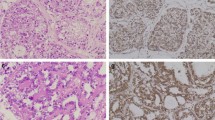Summary
The establishment, growth, and characterization of two new continuously growing human ovarian cancer cell lines (UWOV1 and UWOV2) as, well as a subline (UWOV2, Sf) grown in chemically defined, serum-free medium are described. The cell lines were derived from ascitic tumors of two patients suffering from cystadenocarcinomas of the ovary. Both UWOV1 and UWOV2 lines grow in anchorage-dependent fashion as monolayers, whereas UWOV2 (Sf) forms multilayered domelike structures. Cytogenetic studies revealed nonrandom abnormalities involving chromosomes 1 and 11 in all three cell lines. Secretion of soluble collagen was detected in all three cell lines. In addition, UWOV2 (Sf) produces and secretes large amounts of extracellular matrix material with an ordered fibrillar structure which may function as an attachment factor for the serum-free cells. These cell lines seem to be useful for further studies of the biology of human ovarian cancer.
Similar content being viewed by others
References
Aitkin, N. B. Chromosome 1 aberrations in cancer. Cancer Genet. Cytogenet. 21:279–285; 1986.
Alitalo, K.; Keski-Oja, J.; Vaheri, A. Extracellular matrix proteins characterize human tumour cell lines. Int. J. Cancer 27:755–761; 1981.
Antoniades, H.; Owen, A. Growth factors and regulation of cell growth. Ann. Rev. Med. 33:445–463; 1982.
Barnes, D.; Sato, G. Methods for growth of cultured cells in serum-free medium. Anal. Biochm. 102:255–270; 1980.
Barnes, D.; Sato, G. Serum-free cell culture: a unifying approach. Cell 22:649–655;1980.
Barnes, D.; van der Bosch, J.; Masui, H., et al. The culture of human tumour cells in serum-free medium. Methods Enzymol. 79:368–391; 1981.
De Clerck, Y.; Lee, C. Collagen biosynthesis in human neuroblastoma cell lines: evidence for expression of glial cell properties. JNCI 75:431–439; 1985.
Dickson, C.; Robinson, T. Differentiating cardiac elastin, collagen and microfibrils with NaOH at the ultrastructural level. Histochemistry 89:105–107; 1988.
Diegelmann, R.; Peterkofsky, A. Collagen biosynthesis during connective tissue development in chick embryo. Dev. Biol. 28:443–453; 1972.
Elsdale, T.; Bard, J. Collagen substrate for studies on cell behaviour. J. Cell Biol. 54:626–637; 1972.
Freedman, R.; Pihl, E.; Kusyk, C., et al. Characterization of an ovarian carcinoma cell line. Cancer 42:2352–2359; 1978.
Gilbert, F.; Feder, M.; Balabon, G., et al. Human neuroblastomas and abnormalities of chromosomes 1 and 17. Cancer Res. 44:5444–5449; 1984.
Gilbert, S.; Migeon, B.d-Valine as, a selective agent for normal human and rodent epithelial cells in culture. Cell 5:11–17; 1975.
Gross, J.; Bruns, R. Another look at fibrillogenesis. In: The role of extracellular matrix in development. New York: Alan R Liss, Inc.; 1984:479–572.
Hamilton, T.; Young, R.; McKay, W., et al. Characterization of a human ovarian carcinoma cell line (NIH:Ovcar-3) with androgen and estrogen receptors. Cancer Res. 43:5379–5389; 1983.
Hill, B.; Whelan, R.; Gibby, E., et al. Establishment and charactrrisation of three new human ovarian carcinoma cell lines and initial evaluation of their potential in experimental chemotherapy studies. Int. J. Cancer 39:219–225; 1987.
Ishiwata, I.; Ishiwata, C.; Kobayashi, N., et al. Characterization of newly established cell line HUOA from a human ovarian serous cystadenocarcinoma. Acta Obstet. Jpn. 39:831–836; 1987.
Kikushi, Y.; Kizawa, I.; Oomori, K., et al. Establishment of a human ovarian cancer cell line capable of forming ascites in nude mice and effects of tranexamic acid on cell proliferation and ascites formation. Cancer Rec. 47:592–596; 1987.
McGarity, G.; Steiner, T.; Vanaman, V. Detection of mycoplasmal infection of cell cultures by DNA fluorochrome staining. Methods Mycoplasmol. 2:183–189; 1983.
Priest, J. Medical cytogenetics and cell culture, 2nd ed. Philadelphia, PA: Lea & Febiger; 1977.
Sheer, D.; Sheppard, D.; Gorman, P., et al., Cytogenetic analysis of four human ovarian carcinoma cell lines. Cancer Genet. Cytogenet. 26:339–349; 1987.
Shimada, T.; Nakamura, F. Dome formation of keratin, containing agranular cells from rat anterior pituitary gland in vitro. In Vitro Cell. Dev. Biol. 24:1193–1200; 1988.
Smith, A.; Roberts, C.; van Haaften-Day, C., et al. Cytogenetic findings in cell lines derived from four ovarian carcinomas. Cancer Genet. Cytogenet. 24:231–242; 1987.
Trelstad, R. Vacuoles in the embryonic chick corneal epithelium, an epithelium which produces collagen. J. Cell Biol. 48:689–694; 1971.
Trelstad, R.; Hayashi, K.; Gross, J. Collagen fibrillogenesis' intermediate aggregates and suprafibrillar order. Proc. Natl. Acad. Sci. USA 73:4027–4031; 1976.
Whang-Peng, J.; Knutsen, T.; Douglass, E., et al., Cytogenetic studies in ovarian cancer. Cancer Genet. Cytogenet. 11:92–106; 1984.
Wilson, A. Characterization of a cell line derived from the ascites of a patient with papillary serous cystadenocarcinoma of the ovary. JNCI 72:513–521; 1984.
Wolf, R.; Hayward, I.; Lawrie, S., et al. Cellular heterogeneity and drug resistance in two ovarian adenocarcinoma cell lines derived from a single patient. Int. J. Cancer 39:695–702; 1987.
Woods, L.; Morgan, R.; Quinn, L., et al. Comparison of four new cell lines from patients with adenocarcinoma of the ovary. Cancer Res. 39:4449–4459; 1979.
World Health Organization. Standardisation of procedures for the study of glucose-6-phosphate dehydrogenase and World Health Organization. Technical Reports Series No. 366; 1967.
Zirvi, K.; Chee, D.; Hill, G. Continuous growth of human tumour cell lines in serum-free media. In Vitro Cell. Dev. Biol. 22:369–374; 1986.
Author information
Authors and Affiliations
Additional information
This research was supported by grants from National Cancer Association (S. A.) and Bekker Trust Foundation.
Rights and permissions
About this article
Cite this article
Golombick, T., Dansey, R., Bezwoda, W.R. et al. Establishment and characterization of two new human ovarian cancer cell lines UWOV1 and UWOV2 and a subline UWOV2 (Sf) growing in serum-free conditions: Growth characteristics, biochemical, and cytogenetic studies. In Vitro Cell Dev Biol 26, 447–454 (1990). https://doi.org/10.1007/BF02624086
Received:
Accepted:
Issue Date:
DOI: https://doi.org/10.1007/BF02624086



